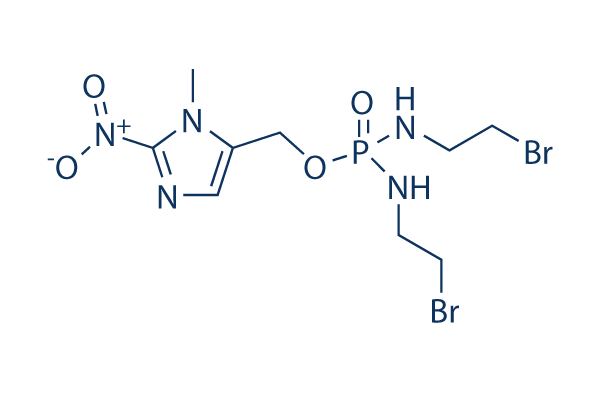|
受注:045-509-1970 |
技術サポート:[email protected] 平日9:00〜18:00 1営業日以内にご連絡を差し上げます |
化学情報

|
Synonyms | Storage (From the date of receipt) |
3 years -20°C powder 1 years -80°C in solvent |
|
| 化学式 | C9H16Br2N5O4P |
|||
| 分子量 | 449.04 | CAS No. | 918633-87-1 | |
| Solubility (25°C)* | 体外 | DMSO | 90 mg/mL (200.42 mM) | |
| Ethanol | 90 mg/mL (200.42 mM) | |||
| Water | 10 mg/mL warmed with 50ºC water bath (22.26 mM) | |||
|
* <1 mg/ml means slightly soluble or insoluble. * Please note that Selleck tests the solubility of all compounds in-house, and the actual solubility may differ slightly from published values. This is normal and is due to slight batch-to-batch variations. |
||||
溶剤液(一定の濃度)を調合する
生物活性
| 製品説明 | Evofosfamide (TH-302)は、19nMのIC50で固形腫瘍の低酸素部位を目標としている選択的な低酸素を起動するプロドラッグです。 |
|---|---|
| in vitro | TH-302 is selectively potent under hypoxia and stable to liver microsomes. Substitution of the chlorine with bromine on the phosphorus mustard in 3b increases the potency by 10-fold and maintaines the high hypoxic selectivity [Hypoxia cytotoxicity ratio (HCR) = 270]. In both human lung cancer H460 cells and human colon cancer HT29 cells, potent cytotoxicity of TH-302 is observed under N2. TH-302 inhibits H460 cells and HT29 cells with IC90 of 0.1 μM and 0.2 μM, respectively. [1] TH-302 shows much enhanced potency in H460 spheroids compared to H460 monolayer cells under normoxia. [2] TH-302 exhibits potent cytotoxicity to MM cells with hypoxic selectivity and dose dependency. TH-302 can induce G0/G1 cell-cycle arrest under hypoxic conditions. The effect of TH-302 on cell-cycle machinery is mediated by down-regulating cyclin D1/2/3, CDK4/6, p21cip-1, p27kip-1, and pRb expression, whereas CDK2 expression remained undisturbed. TH-302 can induce dose-dependent apoptosis in both human and murine MM cells in hypoxic conditions. TH-302-activated apoptosis is mediated through down-regulating the antiapoptotic proteins BCL-2 and BCL-xL, as well as up-regulating the expression of cleaved proapoptotic protein caspase-3, -8, and -9 and poly ADP-ribose polymerase. In contrast to the hypoxia-specific toxicity, TH-302 shows very low toxicity in normoxic condition, even at high concentrations. [3] |
| in vivo | TH302 inhibits primary tumor growth by 41% on day 25 after implantation, whereas TH302 plus gemcitabine (a nucleoside analog) inhibits primary tumor growth by 96% on day 25. [1] When TH-302 is administered at 6.25, 12.5, 25, or 50 mg/kg in the H460 NSCLC xenograft model QD × 5/wk × 2 wks (once a day for 5 days per week for 2 weeks) i.p., the tumor growth inhibition at Day 22 is 43%, 51%, 75%, and 89%, respectively. TH-302 at 100 mg/kg shows a decrease in blood cell counts 3 days after treatment end, but is totally recovered 7 days post-treatment. TH-302 under all tested regimens exhibits efficacy metrics ranging from 58% to 89% tumor growth inhibition. TH-302 induced cell killing is breathing oxygen concentration dependent, with the greatest cytotoxicity occurring when the tumor-bearing mice are exposed to low oxygen concentrations. Tumor growth is significantly reduced by TH-302 in animals breathing 10% O2 compared with 95% O2 breathing. After TH-302 treatment, the pimonidazole-positive area is significantly decreased at 48 hours after dosing (6.3 % in vehicle vs. 1.8 % in the TH-302 treatment group). [4] |
プロトコル(参考用のみ)
| 細胞アッセイ | 細胞株 | Human H460 or HT29 cells |
|---|---|---|
| 濃度 | 0.01 -1 μM | |
| 反応時間 | 2 hours | |
| 実験の流れ | Exponentially growing human H460 or HT29 cells are seeded into 60 mm notched glass plates at 3 × 105 cells per plate and grown in RPMI medium supplemented with 10% fetal bovine serum for 2 days prior to initiating treatment. On the day of the test, TH-302 stocks of known concentrations are prepared in complete medium and 2 mL of the desired stock is added to each plate. The plates are placed in either an anaerobic chamber or a standard tissue-culture incubator. The anaerobic chamber is evacuated and gassed with the anaerobic gas mixture (90% N2/5% CO2/5% H2) to create a hypoxic environment. Cells are then incubated with TH-302 for 2 hours at 37 °C. At the end of treatment, plates are removed from each vessel and washed with phosphate-buffered saline and a solution of trypsin-EDTA and then trypsinized for 5 min at 37 °C. Detached cells are neutralized with medium plus serum and spun for 5 min at 100g. Cells are resuspended at approximately 1 × 106 cells/mL and diluted 10-fold for plating. The exact concentration of each stock is determined. Known numbers of cells are plated and placed undisturbed in an incubator for between 9 and 13 days. Colonies are fixed and stained with a solution of 95% ethanol with 0.25% crystal violet stain. Colonies of greater than 50 cells are counted, and the surviving fraction is determined. Plating efficiencies (PEs) are determined by dividing the number of colonies by the actual number of cells plated. Surviving fractions are calculated by dividing the PEs of treated cells by the PEs of untreate | |
| 動物実験 | 動物モデル | H460, Calu-6, PC-3, H82, A375, Stew2, 786-O, PLC/PRF/5, Hs766t, BxPC-3, and SU.86.86 xenografts are established in NCI SCID female mice. |
| 投薬量 | 50 mg/kg | |
| 投与方法 | Intraperitoneally |
参考
Selleckの高級品が、幾つかの出版された研究調査結果(以下を含む)で使われた:
| Predicting response to combination evofosfamide and immunotherapy under hypoxic conditions in murine models of colon cancer [ Math Biosci Eng, 2023, 20(10):17625-17645] | PubMed: 38052529 |
| 18F-FMISO PET Imaging Identifies Hypoxia and Immunosuppressive Tumor Microenvironments and Guides Targeted Evofosfamide Therapy in Tumors Refractory to PD-1 and CTLA-4 Inhibition [ Clin Cancer Res, 2021, clincanres.2394.2021] | PubMed: 34615724 |
| Enhancement of hypoxia-activated prodrug TH-302 anti-tumor activity by Chk1 inhibition [Meng F BMC Cancer, 2015, 15:422] | PubMed: 25994202 |
長期の保管のために-20°Cの下で製品を保ってください。
人間や獣医の診断であるか治療的な使用のためにでない。
各々の製品のための特定の保管と取扱い情報は、製品データシートの上で示されます。大部分のSelleck製品は、推薦された状況の下で安定です。製品は、推薦された保管温度と異なる温度で、時々出荷されます。長期の保管のために必要とされてそれと異なる温度で、多くの製品は、短期もので安定です。品質を維持するが、夜通しの積荷のために最も経済的な貯蔵状況を用いてあなたの送料を保存する状況の下に、製品が出荷されることを、我々は確実とします。製品の受領と同時に、製品データシートの上で貯蔵推薦に従ってください。
